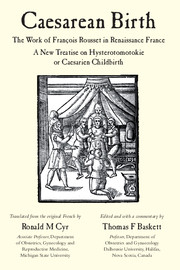 Caesarean Birth
Caesarean Birth Book contents
- Frontmatter
- Contents
- Acknowledgements
- Preface
- Translator's introduction
- François Rousset and the first text on caesarean section: a commentary by Thomas F Baskett
- A New Treatise on Hysterotomotokie or Caesarien Childbirth
- Sonnet
- Dedication
- Preface to the reader
- Part 1 Definition of caesarean childbirth
- Part 2 Second proof: logic (reason)
- Part 3 Third justification: expert opinion
- Part 4 Examples documenting other worse dangers from similar operations that are not caesarean
- Part 5 Other more popular justifications
- Part 6 On the fertility that remains after caesarean section
- A short guide to surgeons on the technique of caesarean
- Approbation
- Copyright
- Appendix 1 Summary of 16th century French history
- Appendix 2 Renée de France (1510–1575), Duchess of Ferrara, Chartres, Montargis and Nemours
- Appendix 3 Jacques de Savoie-Nemours (1531–1585), Duc de Nemours and Genevois
- Index
Part 5 - Other more popular justifications
Published online by Cambridge University Press: 05 June 2014
- Frontmatter
- Contents
- Acknowledgements
- Preface
- Translator's introduction
- François Rousset and the first text on caesarean section: a commentary by Thomas F Baskett
- A New Treatise on Hysterotomotokie or Caesarien Childbirth
- Sonnet
- Dedication
- Preface to the reader
- Part 1 Definition of caesarean childbirth
- Part 2 Second proof: logic (reason)
- Part 3 Third justification: expert opinion
- Part 4 Examples documenting other worse dangers from similar operations that are not caesarean
- Part 5 Other more popular justifications
- Part 6 On the fertility that remains after caesarean section
- A short guide to surgeons on the technique of caesarean
- Approbation
- Copyright
- Appendix 1 Summary of 16th century French history
- Appendix 2 Renée de France (1510–1575), Duchess of Ferrara, Chartres, Montargis and Nemours
- Appendix 3 Jacques de Savoie-Nemours (1531–1585), Duc de Nemours and Genevois
- Index
Summary
If some curmudgeon or sworn enemy of the truth is so irrational that he stubbornly refuses to believe all the case histories or, from sheer laziness, to go see for himself or to concede the force of the arguments proposed above, I will introduce him to some old gelders, who will serve as advocates against him under the elm tree and as village teachers to him – enough to convince him beyond reply. When these masters geld young fillies, sows or bitches, some remove only the spermatic vessels (that they call ‘amours’), some the female testicles (that they call ‘buttons’), others the uterus (that they call ‘porture’). But if these animals are mature, they prefer to geld them when they are pregnant, as much because it is easier to find the uterus, as because they believe it to be more effective; although a few of the less skilled would be content merely to remove the said ‘amours’, verifying that they abort their offspring within three days, as usually happens. The others remove the fetuses to feed to their dog, something that can only be done by incising the uterus. The best gelders remove the entire uterus, or a good part of it, to prevent them from going into heat and stimulating the males to approach them – which is dangerous for mares. After this operation they only put in a few stitches and cover the wound with lard, nut oil, fireplace ash and sometimes soot, to protect from flies or worms.
- Type
- Chapter
- Information
- Caesarean BirthThe Work of François Rousset in Renaissance France - A New Treatise on Hysterotomotokie or Caesarian Childbirth, pp. 85 - 90Publisher: Cambridge University PressPrint publication year: 2010


